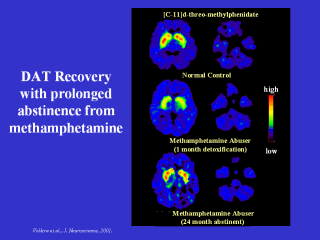Search inside of Supercourse and lectures in HTML and PPT format
 |
 |
front |1 |2 |3 |4 |5 |6 |7 |8 |9 |10 |11 |12 |13 |14 |15 |16 |17 |18 |19 |20 |21 |22 |23 |24 |25 |26 |27 |28 |29 |30 |31 |32 |33 |34 |35 |36 |37 |38 |39 |40 |review |
 It takes time, but the brain can recover. This slide shows images of dopamine transporter (DAT) binding in three brains: (1) a healthy control (top); (2) a methamphetamine abuser one month after discontinuing drug abuse (middle); and (3) a methamphetamine abuser after 24 months of abstinence (bottom). The control brain shows a robust concentration of dopamine transporters in the striatum (red and yellow), while the methamphetamine abuser has a dramatic drop in DAT binding, even a month after drug abuse has stopped. Two years of abstinence, however, allows a near-full return of DAT binding to normal levels. Still, some of the behavioral effects of methamphetamine do not completely return to normal (not shown). This means that it can take a long time to recover from methamphetamine abuse, but recovery is possible. |